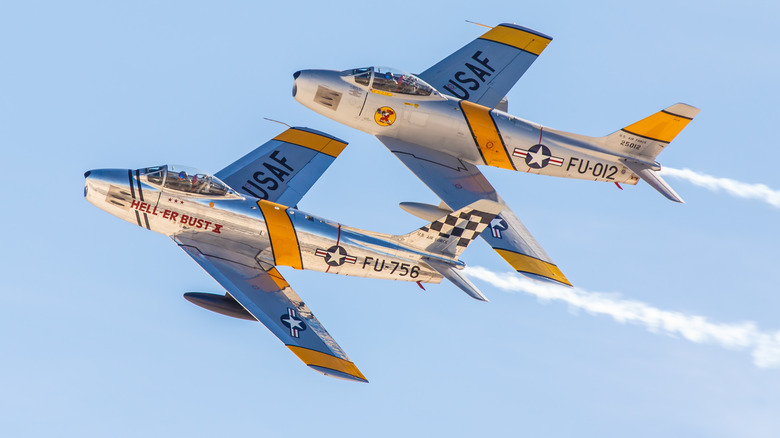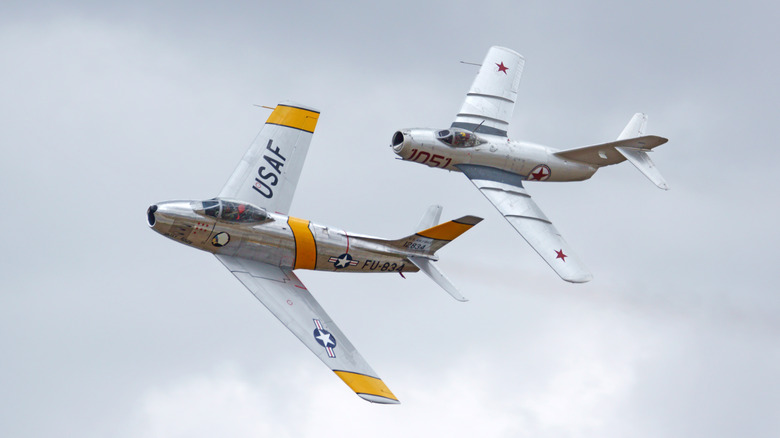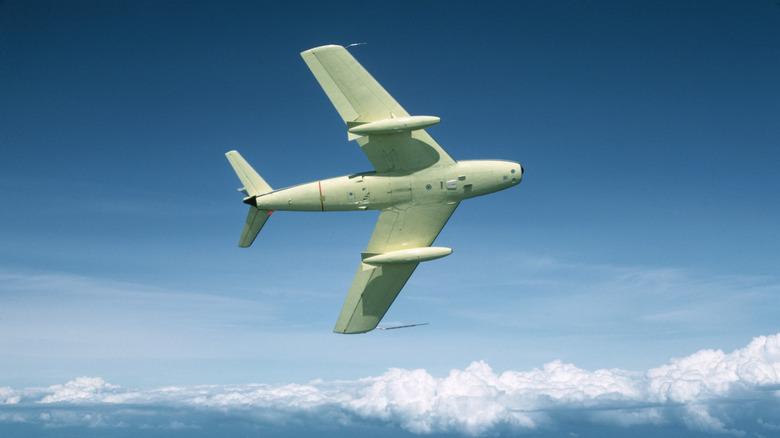How The North American F-86 Sabre Jet Ruled The Skies During The Korean War
In November of 1950, only five months into the Korean War, the Soviets claimed air superiority with their MiG-15s. Thanks to the aircraft's high operating ceiling, speed, and design for intercepting bombers, they were able to end daylight operations conducted by America's B-29 Superfortresses. An aircraft that could fly near the speed of sound and arm itself with two 23-mm and one 37-mm gun firing exploding shells wasn't easily reckoned with. That's where the F-86 Sabre was able to turn the tide.
Based on German engineering with swept-back wings and the Navy's FJ Fury series of aircraft, the Sabre became operational in 1949 and entered service for the United States Air Force. In December of 1950, the Sabre entered the Korean War, initiating the first large-scale jet fighter combat in history with every intention of ending the MiG-15's dominance in the air. It didn't take long for the Sabre to become the primary air-to-air fighter during the Korean War, relinquishing the Soviet adversary of their supremacy. What made the F-86 Sabre one of the most advanced fighters of the Korean War?
It had how many machine guns?
When everybody thinks about air-to-air combat in modern terms, they think about jets letting laser-guided missiles loose that hurtle toward their enemies at faster-than-sound speeds. However, the first jet to fire guided missiles was a Sabre in 1958, flown by Chinese Nationalists. Much like World War II, aircraft at the time relied on machine guns and lining up with their adversaries to get a clear shot. Where the MiG-15 claimed superiority with its three individual guns, the Sabre knocked the MiG off its throne with six cannons. Not just any cannons either, .50 caliber machine guns. They could also outfit the Sabre with bombs and rockets if a mission required it.
When the dust settled, and the war ended, American Sabres shot down a total of 792 MiG-15s. Thanks to their training, this resulted in an 8:1 kill ratio, with 39 Sabre pilots earning "ace" status during the war. To earn ace status, a fighter pilot has to shoot down at least five enemy aircraft. While that number has decreased over the decades thanks to anti-aircraft and tracking technology, the required number during the Korean War was five.
There was no need for speed
It's easy to judge modern fighter jets based on their top speed because civilians expect that to be the number one quality in combat. However, it accounts for a small aspect of aerial combat, and no other aircraft proved that better than the Sabre. The F-86 Sabre's maximum speed only reached 685 mph, not even faster than the speed of sound, which it could only break if it were in a dive. Its typical cruising speed was 550 mph.
However, between the meticulous training F-86 pilots underwent and the superior handling characteristics of the craft, the MiG-15 (which North Korea still uses today) and its pilots were no match for the Sabre. The Sabre became such a favorite during the war that the military commissioned multiple variations of it, from the F-86A version to the F-86F, and America wasn't the only country to use them.


